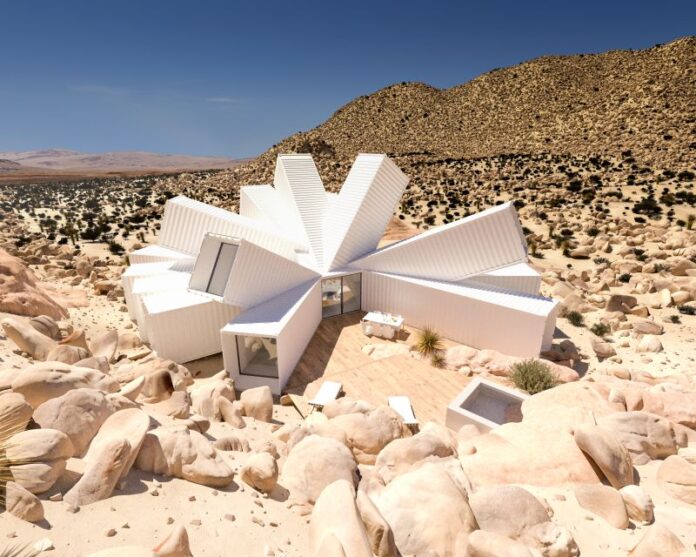In the dynamic landscape of modern architecture, one might most associate innovation with sleek glass towers and sprawling suburban homes. Yet, beneath the surface, a quiet revolution is taking place with the utilization of shipping containers, originally designed for transporting goods across oceans. This journey began in 1937 with Malcolm McLean, a visionary truck driver who, frustrated with the inefficiencies of cargo transfer at the docks, dreamed of a more effective solution.
The Birth of the Container Concept
As McLean observed longshoremen laboriously moving boxes onto ships by hand, he envisioned a system where goods could be transported in large, secure metal containers that could seamlessly transfer from trucks to ships. This idea culminated in 1956 when McLean loaded a former warship with 58 containers, ready to unveil the intermodal container. Ironically, while he sought to streamline shipping logistics, he inadvertently sparked a design and sustainability movement that continues to evolve today.
A New Architectural Frontier
Initially, these containers found a secondary use as portable showcases for trade fairs, revealing their versatility beyond maritime transportation. By the late 1980s, innovators were looking at containers not just for temporary installations but as building blocks for permanent structures. A notable early instance occurred when futurist Stuart Brand authored “How Buildings Learn,” while living in a converted shipping container, giving voice to an emerging movement known as “cargotecture.”
Pioneers of Container Architecture
American architect Adam Kalkin emerged in the 2000s as a pioneering figure in container architecture. His work spans luxury homes and orphanages, characterized by an emphasis on creativity and playful design. Kalkin opined that while many architects use containers as mere low-cost widgets, he sought projects that transcend conventional homes, exemplified by the Push Button House, which utilizes hydraulic technology to create a portable living space that expands at the push of a button.
His projects, such as the elegant 12 Container House, not only highlight the functional potential of shipping containers but also emphasize the opportunity to innovate in sustainable design. This vision aligns with Kalkin’s observation that the growing acceptance of container structures means that each project can redefine the future of that architecture. The evolution has led to a fusion of environmentalism with cutting-edge technology, creating exciting design possibilities.
Overcoming Barriers to Creativity
Architect Peter DeMaria is another key player who helped shape container architecture. His Redondo Beach House made headlines as the first two-story container structure compliant with the California building code for earthquake durability. DeMaria’s approach, which combined durable materials with modern aesthetics, questioned traditional notions of home design. “What can a home be?” became a guiding principle in his work, paving the way for numerous projects that sustain the integrity of innovative practices in construction.
Containers have proven their resilience to fire, mold, and pest damage, making them attractive building materials. Their affordability and ubiquity enable activists and designers to think outside the box—literally—creating innovative, upwardly mobile housing solutions without the high costs of traditional construction.
Diverse Design Applications
Today, the adaptability of shipping containers extends far beyond residential designs. They have been employed to create temporary housing for disaster relief, student dormitories, cafes, and even schools. One such notable project is Bjarke Ingels’ Urban Rigger in Copenhagen, a floating student accommodation made from repurposed containers.
Containers are also garnering attention from large-scale developers. For instance, plans have been proposed for stadiums constructed entirely from containers; Fenwick Iribarren Architects has suggested repurposing containers for a venue hosting the FIFA World Cup, allowing for easy dismantling and relocation after events. This not only addresses ecological concerns but also strives to eliminate waste and promote sustainability.
The Artistic Identity of Containers
The industrial aesthetic of container architecture has not gone unnoticed by designers. Roger Wade, the founder of Boxpark, utilized shipping containers to create one of the world’s first pop-up malls in London’s Shoreditch district in 2011, revolutionizing retail options in urban settings. However, Wade cautions against losing sight of the functional properties of genuine shipping containers amid the trend’s proliferation, as many designs prioritize appearance over practicality.
The Future of Cargotecture
As the popularity of container architecture continues to rise, it raises questions about its long-term implications. There are purists who champion containers for their structural integrity and efficiency, while others exploit the trend merely as an aesthetic layer. Yet, as DeMaria aptly notes, within this spectrum, creativity flourishes—from exceptional projects that push architectural boundaries to misguided designs that misinterpret the fundamental ethos of containers.
Conclusion
The journey from McLean’s revolutionary idea to the modern interpretation of shipping containers highlights an exciting intersection between functionality and creativity. As we reflect on the evolution of cargo containers from simple metal boxes to sources of pride for architects and builders, one thing is certain: the future of container architecture promises to be inventive, efficient, and profoundly impactful on urban landscapes worldwide. As we redefine what buildings can be, we also reimagine the spaces we inhabit, fostering a sustainable dialogue between structure and environment.














